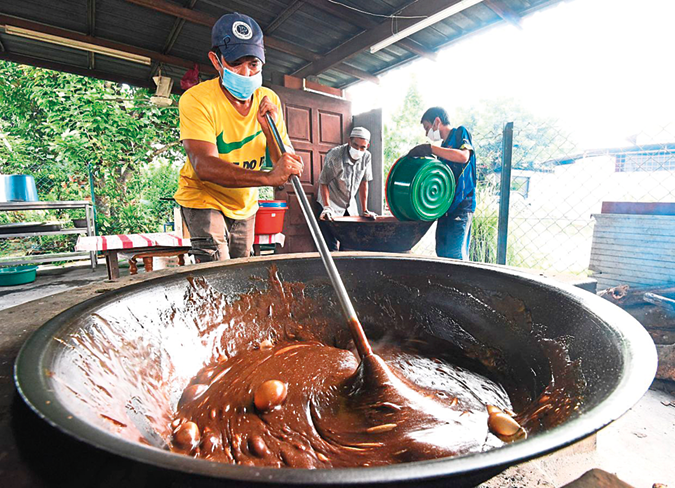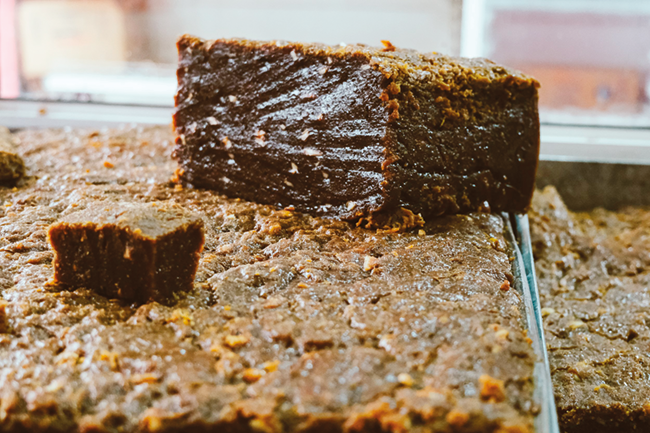Life style
A Sticky Sri Lankan Dessert Steeped in History

By Zinara Rathnayake
When I was five years old, I would love to sit beside my loku amma, solving riddles while she worked in the kitchen making kalu dodol. Loku amma was married to my paternal uncle, my father’s older brother. As a young girl, I loved my chatty, always laughing, childlike loku amma for many reasons. But more than anything, I longed for her kalu dodol, a dark brown, gelatinous Sri Lankan sweetmeat made with rice flour, coconut milk and palm jaggery. For loku amma, making dodol in her outside kitchen in Kurunegala, a town 100 km north of the country’s capital, Colombo, was a monthly ritual.
For about 2 kg of dodol (as kalu dodol is also known), you need 300 g of rice flour, fresh and creamy coconut milk from three mature nuts, and at least 1 kg of palm jaggery. Despite everyone’s tut-tutting about the domestic drudgery that dodol making entails, loku amma did it with a cheerful smile.
“It’s easier to buy it from a shop,” my uncle, parents and cousins complained. Loku amma brushed them off without a word, and headed off to their large, one-acre back garden dotted with coconut palms. Preparations for dodol making began the previous day with plucking coconuts. Her son would then cycle to the nearby mill with farm-grown rice, and bring home rice flour.
In the wee hours of the next morning, loku amma would halve coconuts with a sharp sickle and scrape their flesh for hours. Sometimes, her son would chip in to help. They squeezed the grated coconut in water to make coconut milk. Once her son made a hearth in the back garden with bricks, loku amma would add to a large vat coconut milk, sieved rice flour, and palm sugar — a specialty of her hometown near the hill town of Kandy.
For the next four hours, family members would take turns stirring the mixture. Their job also involved adding parched twigs and coconut shells to the fire beneath the vat. As it cooked, the mixture began to release oil. Once they carefully spooned out the oil from the kalu dodol batter, it slowly began to fuse, merging into a scrumptious lump that didn’t stick to your fingers. Loku amma laid this on a large tray, allowing it to cool for an hour before cutting it into medium-sized blocks —slightly crusty outside and wonderfully gooey within.
When I turned ten years old, I left for school in Kandy and my visits to loku amma’s house became fewer. After her husband’s death about a decade ago, she slowly forgot about her ritualistic dodol making. At age 75, loku amma now gently oversees while her children make dodol once a year in April, to mark the Sinhala and Tamil New Year. It’s been several years since I last tasted loku amma’s dodol, but whenever I come across the sweetmeat of my childhood, I think of no one but her.
While kalu dodol forms a happy, vivid memory of my early years, it was only recently that I learned that it is also deeply yoked to Sri Lanka’s history. In a paper published in the Journal of Ethnic Foods, the authors suggest that dodol — a sweet, toffee-like confection — is a heritage food of the Malay community, whose origins are linked to the Malay Archipelago, between mainland Indochina and Australia.
The oldest written records about dodol in the early 20th century are associated with the Malay community in Batavia, Indonesia during the Dutch colonial period. In 1926, an entrepreneur named Karsinah from the Garut Regency in Indonesia is believed to have initiated the commercial production of dodol.
According to the research, dodol is also a type of kuih, a Malay cake or dessert that “symbolizes the Malay identity and represents its history, lifestyle, and heritage.” As historical records mention, kalu dodol in Sri Lanka also traces back to Malay settlers on the island. Today, the small community has a population of around 40,000 people in Sri Lanka.
Although collectively known as Sri Lankan Malays, this diverse community includes people of varied Southeast Asian ancestry, from Malaysia to the easternmost parts of the Indonesian archipelago. In their paper The Lifecycle of Sri Lanka Malay, authors Umberto Ansaldo and Lisa Lim mention that convicts and enslaved groups of people from the Indonesian archipelago arrived in Sri Lanka as early as the 16th century, during Portuguese rule. But most Sri Lankan Malays trace their roots to the Dutch colonial period from 1658 to 1796. Deported political exiles from Java, Maluku and Goa, among other places, came to Sri Lanka.
Later, during the same period, more people arrived from Bali, Java and the Malaysian peninsula; most of them were soldiers. The Dutch formed a Malay brigade to fight against Sri Lankans, a practice also followed by the British when they occupied the island in 1815. Collectively, the native inhabitants labelled these groups from the Malay Archipelago and beyond as Ja Minissu or Ja Manusar — Sinhala and Tamil respectively for people from Java. When British colonisers noticed that the people spoke Malay, they gave them the ethnic label of Sri Lankan Malays.
Another theory goes that kalu dodol was introduced to Sri Lanka by the Portuguese. Perhaps there is some truth to this, as dodol has also become a cultural artefact in former Portuguese colonies such as nearby Goa, Macau, Tanzania and certain East African nations. “It could be true that colonial rulers brought it from Goa and South Indian colonies,” said Diwani Welitharage, a food blogger who researches widely about Sri Lankan food. “But the tradition of dodol making began in the south of Sri Lanka. So perhaps it came with Malay settlers who entered the island from a southern port.”
While there is little literature available on Malay cultural ties to kalu dodol in Sri Lanka, the dessert is believed to have its roots in Hambantota in the south of the country, which had a thriving Malay community in the past. The name Hambantota derives from Sampan Tota, which translates to the “harbour of the sampans,” referring to a type of wooden boat used by the Malays.
While the community has dwindled, Malays still hold fast to their heritage desserts such as dodol. Over the years, dodol has become enwrapped in other cultures and communities across the island. Sinhalese groups line the streets with dodol stalls during cultural processions in Kataragama, a town in Hambantota that holds religious significance for both Buddhists and Hindus. Meanwhile, Sri Lankan Moors, whose history traces to Arab traders, also prepare dodol.
There’s no doubt that dodol travelled across the world as a result of colonialism. Perhaps the forced migration of various groups hailing from the Malay archipelago also played a part. As this Malay sweetmeat moved from one place to another, shaped by the cuisines, rituals and customs of the communities across the world who came to embrace it, it became a celebratory dessert reserved for festivals.
For Goans, dodol is a luscious sweetmeat made during Christmas, while Thais make it to mark their new year, Songkran. Sri Lankan Muslims prepare dodol for Eid. This shared love for dodol has led to several iterations of the dessert.
The Thai community, for example, garnishes dodol with roasted white sesame seeds. The Malaysian city Melaka is famous for dodol pisang (banana dodol) and dodol kopi (coffee-flavoured dodol), among others. Another famous Malaysian version of the dish is dodol durian, which uses the odorous flesh of the durian fruit.
The most common versions of dodol include rice flour, coconut milk and palm sugar or jaggery. While Southeast Asian countries often use glutinous rice flour, in Sri Lanka, we often grind our own flour from local rice varieties, which are usually less sticky.
Kalu dodol means black or dark dodol in Sinhala. The darker it is, the better it is believed to taste. This is because the darker colour indicates the amount of pure kithul jaggery present in the dish. Although the Malay community in Southeast Asia often uses palm sugar from the black sugar palm or coconut trees, kithul jaggery is made from the sap of the kithul palm (or foxtail palm) tree, which grows abundantly in the low wetlands in Sri Lanka. Kithul jaggery lends a smoky flavour to the dish.
“But many businesses now add sugar,” said Ilma Nawas, a Malay resident from Hambantota who learned to make dodol from his mother.
Commercial dodol makers, Nawas explained, also swap rice flour with refined flour. According to Niwas, the rich oily texture in dodol should come from creamy coconut milk. However, this is not always the case. “We never add oil to dodol, but most businesses don’t use pure coconut milk or reduce the amount [of milk] that they use. Instead, they add cheap cooking oil to the mixture to give the oily [mouth] feel,” he said.
Apart from making dodol for festivals, Nawas’ family also occasionally takes orders. Depending on what people prefer, they add different ingredients to the batter. This often includes ground cardamoms. As dodol became commercially available in Sri Lanka, dodol-making machines made their way to the island.
“But they make dodol too soft and silky,” said Asha Sewmini, an ambitious entrepreneur. Sandwiched between assorted shops on a busy street in Nugegoda, a suburb of Colombo, her shop Dilani Kalu Dodol sells dodol from Hambantota, their hometown, where they still live. According to Sewmini, manually stirring the mixture lends the dish its signature uneven texture. “Some parts will be crumbly and lumpy while others are soft, smooth, and gooey,” she said. “That’s the joy of eating dodol.”
Sewmini inherited her dodol recipes from her late grandmother. Forty years ago, her mother assembled a makeshift stall during the procession season in Kataragama. “Our house sits along the Kataragama road. So amma sold dodol to the pilgrims,” she said. “People would see the stall, stop their vehicle and buy it from us.”
Dilani Kalu Dodol has expanded over the years. They began supplying to restaurants and supermarkets, and opened a small outlet in Colombo. Sewmini attributes their success to their hard work and the quality of the ingredients they use, such as adding enough cashews for extra crunch and always favouring jaggery instead of sugar. “It makes all the difference in taste and texture,” Sewmini said.
In the cosmopolitan towns of Sri Lanka today, you are more likely to head home with a slab of dodol that’s prepared “cheaply”, as Nawas calls it. But wedged between high-rise structures and profit-minded ventures, small stores like Dilani Kalu Dodol are still preserving their family heritage.
“I know we can easily profit [from dodol] by using sugar or cooking oil, but we never do that,” Nawas said. “I learned to make dodol from my mother; she learned it from her mother. This is our family recipe. The original dodol. Better than anything you can get in the market.”
Some people also opt for sago or roasted and crushed mung beans in their dodol. No matter what ingredients may go into dodol, the key to getting it right is to stir the mixture often. Stirring, Nawas says, helps form the perfect crusty outside, smooth inside texture. “It also prevents the batter from sticking to the pan,” he said. “Sometimes, my hands start to hurt. But I can’t look away. If you do, your dodol is gone; the mixture will stick to the pan.” (BBC)
